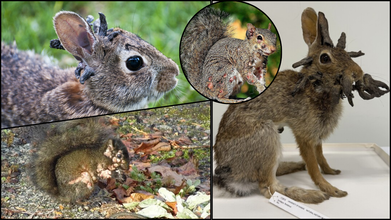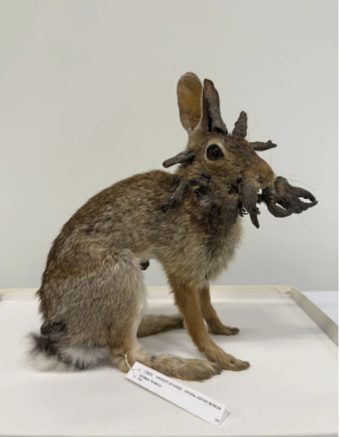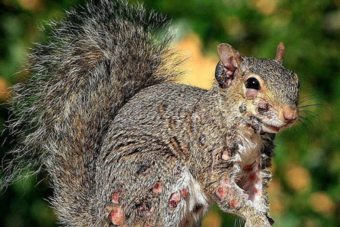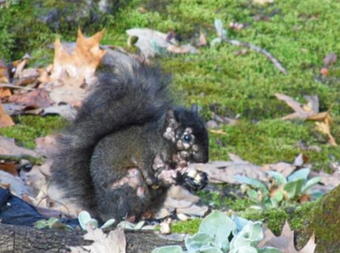- Health Conditions A-Z
- Health & Wellness
- Nutrition
- Fitness
- Health News
- Ayurveda
- Videos
- Medicine A-Z
- Parenting
- Web Stories
From 'Frankenstein Rabbits' To 'Zombie Squirrels': What These Unsettling Traits Reveal About Parasitic Illnesses

Credits: AP/Evelyn's Wildlife Refuge/X
Every summer, social media fills with unsettling images of backyard wildlife that look more like extras from a low-budget horror movie than neighborhood critters. This year, it’s squirrels with grotesque sores and rabbits sprouting what appear to be black, tentacle-like horns from their heads. While the sight is shocking, scientists say these conditions are less terrifying than they appear—and in many ways, they’re teaching us important lessons about viruses, immunity, and even human health.
In northern Colorado, residents recently spotted wild rabbits with twisted, horn-like growths protruding from their faces. Reports came in from Fort Collins, where some of these animals looked like they had sprouted black tentacles instead of fur.
What Are Frankenstein Rabbits?
Colorado Parks and Wildlife (CPW) quickly confirmed the culprit- Shope papillomavirus, a virus first identified in the 1930s. The infection causes keratin-based growths made of the same material as human nails and hair—that can grow into elongated, horn-like shapes.

For most rabbits, the infection is temporary. “They’re able to clear it from their system on their own,” says Kara Van Hoose, CPW spokesperson. Once the immune system suppresses the virus, the horns dry out and eventually fall off. But in some cases, the growths can interfere with eating, foraging, or even vision. Rarely, they can develop into squamous cell cancers.
Importantly, Shope papillomavirus only infects rabbits and hares—not humans or pets. The growths themselves aren’t contagious. Instead, the virus spreads via bites from mosquitoes, fleas, and ticks, which is why sightings spike in summer and then fade with the first frosts.
Also Read: Unique Symptoms Of Lyme Disease In 2025 And How Long Infection Now Last
A Virus with A Surprising Legacy
The rabbit virus may look like a strange wildlife quirk, but its scientific significance is immense. Richard Shope, the virologist who identified it in 1933, later contributed to research on influenza A and traced links to the deadly 1918 flu pandemic.
Even more importantly, his studies of rabbit papillomavirus helped scientists understand human papillomavirus (HPV), a pathogen now known to cause several cancers. This research eventually led to the development of the HPV vaccine, one of the most effective tools in modern cancer prevention.
In other words, the bizarre-looking horned rabbits of Colorado are part of a story that connects animal health, human medicine, and the fight against one of the world’s leading cancer-causing viruses.
What Are Zombie Squirrels?
If the horned rabbits weren’t alarming enough, homeowners across the U.S. and Canada have reported squirrels with grotesque, oozing sores. Dubbed “zombie squirrels” on Reddit and local news outlets, these animals often appear bald, scabby, and covered in tumors.

At first, some feared this was squirrelpox, a rare and often deadly virus primarily found in red squirrels in the U.K. But experts now say that in North America, most cases are actually squirrel fibromatosis, caused by a virus called leporipoxvirus.
Like the rabbit papillomavirus, fibromatosis creates wart-like growths that may burst and ooze fluid. The disease looks disturbing, but it usually clears up on its own within four to eight weeks. Gray squirrels, which are common across the U.S., generally recover fully.
How the Virus Spreads Among Animals?
Unlike the horned rabbit virus, which is spread by biting insects, squirrel fibromatosis spreads through direct contact with infected saliva or lesions. That means the backyard bird feeder—a favorite stop for squirrels—can act as a transmission hub. Infected squirrels may leave saliva on seeds, which is then picked up by others.

“Shevenell Webb, a wildlife biologist in Maine, explains it like this: ‘It’s like when you get a large concentration of people. If someone is sick and it spreads easily, others are going to catch it.’”
Although it’s upsetting to see squirrels in such poor condition, the disease does not spread to humans, dogs, or cats. Experts strongly advise against touching or attempting to “rescue” infected squirrels.
Should We Worry About Human Risk?
Here’s the key point: Neither rabbit papillomavirus nor squirrel fibromatosis poses a risk to people. These viruses are species-specific, meaning they evolved to target only their animal hosts.
That said, wildlife experts caution against close contact. Wild animals can carry other pathogens, and distressed animals can bite or scratch. The safest approach, they say, is observation from a distance.
At first glance, these conditions look like nothing more than cruel tricks of nature. But the history of virology shows that studying animal viruses has repeatedly advanced human medicine. The rabbit papillomavirus directly contributed to the eventual creation of the HPV vaccine. Even squirrel fibromatosis, though less studied, provides clues about viral behavior, transmission dynamics, and immune response.

There’s also a conservation angle. Tracking these conditions helps wildlife officials monitor population health and understand how environmental changes, including warmer summers and denser urban habitats, may amplify disease spread.
It’s worth noting that both the horned rabbits and zombie squirrels came into the public spotlight through viral photos online. Platforms like Reddit and X (formerly Twitter) have become informal early-warning systems for unusual animal illnesses. While this sometimes fuels fear, it also provides wildlife agencies with useful crowd-sourced data.
As Van Hoose points out, it’s difficult for agencies to know whether multiple sightings represent several infected animals or just the same one seen repeatedly. Public reports when paired with expert analysis help build a clearer picture.
What to Do If You Spot A ‘Frankenstein Rabbits’ or ‘Zombie Squirrels’?
If you see a rabbit with horns or a squirrel with sores, the advice is straightforward:
- Do not touch or feed the animal.
- Do not attempt to trap or euthanize it.
- Report sightings to local wildlife authorities if requested in your area.
These animals, though unsightly, are usually not suffering long-term. Many recover naturally once their immune system clears the virus.
From rabbits with keratin “horns” to squirrels with wart-like sores, these strange cases highlight how deeply intertwined wildlife health is with human understanding of disease. They remind us that viruses are not just human problems—they shape ecosystems, influence evolution, and sometimes, unexpectedly, lead to breakthroughs that save lives.
World Arthritis Day 2025: Date, Theme, Significance And History Explained

Credits: Canva
Every year, people across the world unite on World Arthritis Day to spread awareness about arthritis and related disorders. Observed annually on October 12, the day aims to draw attention to the everyday challenges faced by those living with arthritis, encourage early diagnosis, and promote better medical care and support systems.
As World Arthritis Day 2025 approaches, it’s a timely reminder to learn about its theme, importance, and the role each of us can play in improving the lives of those affected.
Why World Arthritis Day Matters
Arthritis is often mistaken for a simple case of joint pain, but it is far more complex. It includes a wide range of conditions that can impact a person’s mobility, independence, and overall well-being. One of the main goals of World Arthritis Day is to break these misconceptions, spread accurate information, and raise awareness that arthritis can affect anyone, regardless of age.
Raising awareness also encourages timely medical consultation, physiotherapy, and healthier lifestyle choices that can help manage symptoms and prevent complications.
World Arthritis Day 2025 Theme
The theme for World Arthritis Day 2025 is “Realizing Your Dreams” or “The Courage to Dream.” This year’s message highlights the importance of personal aspirations and resilience among people living with rheumatic and musculoskeletal diseases (RMDs). It inspires individuals to pursue their dreams while encouraging collaboration between patients, doctors, and advocates to turn those dreams into reality.
The theme serves as a reminder that arthritis is not just a physical condition, it is about preserving one’s independence, dignity, and quality of life.
When Is World Arthritis Day Celebrated?
World Arthritis Day is marked every year on October 12 around the globe. In India too, this day is recognised and observed to underline the importance of awareness and education about arthritis. With lifestyle changes and rising stress levels, arthritis is now being diagnosed in younger people as well, making awareness even more vital.
Ways to Raise Awareness on World Arthritis Day 2025
Spreading awareness is not limited to medical professionals or organizations. Every individual can help in small but meaningful ways. Some simple ideas include:
- Educational Programs: Schools, offices, and community groups can organize sessions to teach people about arthritis symptoms and preventive care.
- Social Media Campaigns: Sharing real-life stories, verified facts, and official theme posters can reach thousands online.
- Community Events: Walkathons or charity runs can raise both funds and awareness.
- Free Health Camps: Clinics and hospitals can offer free joint check-ups to encourage early diagnosis.
These collective efforts ensure that arthritis is not ignored or misunderstood, but openly discussed and addressed.
Tips for Living with Arthritis
Awareness is the first step, but supporting those who live with arthritis every day is just as important. Here are some ways to help manage the condition and maintain a good quality of life:
Stay Active, but with Care
Choose gentle exercises such as walking, yoga, or swimming to keep joints flexible and reduce stiffness without straining them.
Eat a Balanced Diet
Include anti-inflammatory foods such as leafy greens, fatty fish rich in omega-3, nuts, and olive oil to help ease inflammation.
Get Enough Rest
Quality sleep helps the body recover. Avoid overexertion but stay active enough to prevent stiffness.
Use Supportive Tools if Needed
Walking sticks, braces, or other assistive devices can reduce stress on joints and make movement easier.
Maintain a Positive Outlook
Joining arthritis support groups or connecting with others who share similar experiences can provide motivation and emotional support.
For those seeking specialized treatment, visiting a reputed multispeciality hospital in Coimbatore can help patients receive comprehensive arthritis care, from diagnosis to therapy and rehabilitation, under one roof.
Is Donald Trump Showing Early Phonemic Paraphasia? Here’s Why Health Experts Think So

As Donald Trump recently went for his second health checkup, the visit, announced earlier this week by the White House comes as he prepares to travel to the Middle East following a ceasefire deal in the Israel-Hamas war. White House press secretary Karoline Leavitt called it a “routine yearly checkup,” even though the president had already undergone his annual physical in April. According to a memo obtained by CBS News on Friday evening, written by Trump’s physician, Capt. Sean Barbabella, the president “successfully completed a scheduled follow-up evaluation.”
The president also received his annual flu vaccination and an updated COVID-19 booster. Interestingly, his cardiac age, a validated measure of cardiovascular health via ECG was found to be roughly 14 years younger than his chronological age. However, health experts remain concerned, with many noting potential signs of dementia. Now, some specialists are also pointing to early indicators of phonemic paraphasia in his speech.
What Is Phonemic Paraphasia That Health Experts Believe Donald Trump Has Signs Of?
Phonemic paraphasia is a type of speech error where sounds within a word are substituted, added, or rearranged, creating a nonword that still sounds similar to the intended word (for example, “tephelone” instead of “telephone”). It is commonly seen in language disorders such as Wernicke’s aphasia and conduction aphasia, caused by difficulty selecting the correct phonemic segments. People with this condition usually understand what they want to say but struggle with producing the correct sounds.
What Are Psychologists Saying About Donald Trump’s Health?
Even during Trump’s first term, his cognitive and psychological traits attracted attention. Observers noted he struggled to focus on a single topic, and his public remarks raised concern among psychiatrists. In 2017, 27 mental health professionals collectively published The Dangerous Case of Donald Trump, warning that his mental state, combined with presidential powers, could pose risks to global security.
Dr. Bandy Lee, who taught for 17 years at Yale School of Medicine, first noticed potential neurocognitive issues in Trump in 2017 and says his condition has steadily declined since then. The manifesto, published on Nov. 3, 2024, titled Statement on Cognitive Decline in the Presidential Election, lists symptoms including simpler vocabulary, incomplete sentences, grammatical mistakes, paraphasias, vague or inappropriate statements, compulsive repetition of thoughts (“perseveration”), increased use of profanity, and pronounced narcissistic traits.
Some of Trump’s invented words even went viral during his first term. The infamous “covfefe” tweet is one example, where he likely meant “coverage” but created a nonsensical word that became a meme and appeared on protest signs and in advertisements.
Health Experts Believe Donald Trump Also Has Dementia
Harry Segal, a senior psychology lecturer at Cornell University, has observed early signs of dementia in Trump. “What’s alarming is how the rate of Trump’s unusual speech and political decisions has been increasing. He once gave an incoherent answer about childcare to the Economic Club of New York… Trump has shown evidence of dementia over the past year, indicated by his strange gait, phonemic paraphasia, and a decline in word complexity,” Segal said. He believes these factors explain Trump’s refusal to debate Kamala Harris a second time and his increasingly impulsive speeches.
What Are the Symptoms of Phonemic Paraphasia?
The main symptom is substituting a word with a nonword that sounds similar, such as saying “wishdasher” instead of “dishwasher.” Other signs include:
- Errors where sounds in a word are replaced with different sounds
- Producing non-real words that resemble the intended word
- Difficulty finding words and substituting unrelated terms (semantic paraphasia)
- Repeated attempts to correct themselves, sometimes abandoning the word entirely
- Lack of awareness of these mistakes
Who Is Affected by Phonemic Paraphasia?
- Individuals with aphasia: Particularly Wernicke’s and conduction aphasia
- People with brain lesions: Often in the posterior temporal lobe or internal/external capsules, areas involved in language
- Individuals with other neurological conditions: Early dementia is frequently associated with phonemic paraphasia
Long COVID Is Taking A Silent Toll On Mental Health, Here’s What Experts Say

Credits: Canva
Months after recovering from COVID-19, many people continue to feel unwell. They speak of exhaustion that doesn’t fade, difficulty breathing, or an unsettling mental haze. What’s becoming increasingly clear is that recovery from the virus doesn’t always end when the infection clears. For countless survivors, Long COVID continues to affect both body and mind, often in ways that are deeply disruptive.
We got in touch with Dr Neetu Tiwari, MBBS, MD Psychiatry, Senior Resident, NIIMS Medical College & Hospital, Greater Noida, who told us more about the same.
What Is Long COVID?
Long COVID refers to symptoms that persist for weeks or even months after the acute phase of infection. According to the World Health Organization (WHO), these symptoms can include fatigue, muscle pain, memory lapses, and shortness of breath. But beyond the physical, the virus appears to leave behind a psychological footprint that can be just as debilitating.
Many people who once described themselves as mentally sharp now say they struggle to concentrate or recall simple details. This condition, commonly referred to as “brain fog,” is one of the most reported cognitive symptoms. Others experience ongoing anxiety, irritability, or low mood, emotional states that may feel new or much stronger than before.
The Psychological Toll of Long COVID
For some, Long COVID has amplified pre-existing mental health conditions such as depression or anxiety. For others, it has triggered them for the first time. There’s a growing understanding among psychiatrists that this prolonged stress response is partly biological and partly environmental.
On a biological level, inflammation and prolonged immune activity may alter brain chemistry. This can influence mood regulation, memory, and cognitive performance. On a social level, months of isolation, disrupted routines, job insecurity, and the fear of reinfection have taken their toll. The mind, much like the body, has been in survival mode for far too long.
Why Mental Health Support Is Crucial
One of the biggest challenges in addressing Long COVID is recognizing that recovery is not just physical. Many survivors find themselves dismissed or misunderstood because their symptoms are invisible. Yet, ignoring the psychological component can delay overall healing.
Integrated care, where physicians, psychiatrists, and psychologists work together — is crucial. Treatment may involve supportive psychotherapy, cognitive-behavioral therapy (CBT), mindfulness practices, and, in some cases, medication to manage anxiety, depression, or sleep disturbances. These interventions help patients cope with uncertainty while rebuilding emotional strength.
Reclaiming Mental Wellbeing After COVID
Recovery from Long COVID is not only about regaining physical stamina. It is also about rebuilding confidence, purpose, and connection. Experts emphasize that acknowledging distress is not a sign of weakness; it’s a step toward healing. Even simple habits, maintaining a routine, light exercise, staying connected with friends, or practicing breathing techniques can gradually improve resilience.
Long COVID has taught the world a difficult but necessary lesson: mental health deserves the same urgency and attention as physical health. In the months and years ahead, true recovery will depend not only on medical advances but on compassion, for ourselves and for those still struggling to find their way back to normal life.
© 2024 Bennett, Coleman & Company Limited

